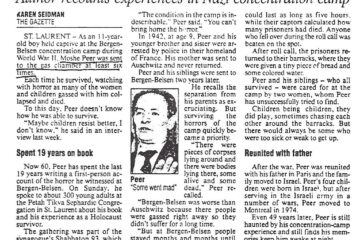Schoolboys at Auschwitz
IMAGINE A SCHOOL field trip in which a class of sixteen-year-olds is taken to visit the fossil filled coastal cliffs of Dorset near Lulworth and Kimmeridge. As the group of students explore the rock strata composing the cliffs, many of them discover the shells of extinct molluscs and some even find belemnites and ammonites, all of which are labelled and placed in specimen bags to be taken back to their class rooms for further examination and study.
At the end of the field trip, some pupils will have not enjoyed the experience, they will have not really been interested and their course work and the dearth of fossils they personally collected will reflect this. Others however will have been thrilled by the experience and will be rewarded by high marks when the teaching staff come to examine their lengthy essays and the extensive array of fossils they collected, and this is how it should be.
Imagine another similar school field trip, in which pupils are taken to visit the site of the English Civil War battlefield at Naseby. The various locations and their significance are explained to the students and they are shown around the visitors’ centre museum* where there are literally thousands of relics of that historic battle on display. The battlefields themselves have been extensively combed for artefacts that might give a clue to the progress of the battle and the people involved and although the site is regarded as a place of historical importance and a war grave, much of the land is now actively farmed and occasionally more remains of dead soldiers are unearthed during the seasonal ploughing and digging that takes place.
As the students explore the battle fields one of the boys who is very keen notices something glinting by the side of the path and upon closer examination he realises that it is a brass button from a Civil War era soldiers tunic, he recognises it because it is very similar to the hundreds already on display in the visitors’ centre. He picks up the button and shows it to his friend and for the rest of their tour of the battle fields they both keep an eye out for similar relics and in doing so discover some fragments of glass from an old bottle and a piece of rusty metal that could be the remains of a spoon from that era.
The boys put these items in their rucksacks and take them home. They don’t regard their actions as theft, because they were like many tens of thousands of similar items strewn unwanted across the battlefields. These items, although thrilling to the boys, were nothing of any great note compared to the tens of thousands of virtually identical items that had already been found and which were already catalogued and on display together with larger, far more significant finds that had been made by generations of professional archaeologists and historians that had dug extensive excavations and thoroughly combed the soil.
Back at school the boys submit the items they collected together with their history project work on the English Civil War and their teachers are delighted with the enthusiasm of the boys and with the detailed descriptions they gave of what they had seen and found during the field trip.
Now let us consider what apparently happened in June of this year when a party of sixteen-year-old students from the £15,000 per annum Perse School in Cambridge visited Auschwitz in Poland, the site of the alleged murder of more than a million people as part of an alleged plan by the German authorities during World War Two to exterminate the Jewish people.
 Like the battlefield at Naseby, the large site comprising the extensive remains of the Auschwitz concentration camp are regarded in some respects as a mass grave, and similar to Naseby but far more extensive. The site has museum facilities displaying, not tens, but hundreds of thousands of relics and artefacts that have been collected and examined, logged and studied by vast numbers of historians over the more than seven decades that have elapsed since Auschwitz was liberated in 1945.
Like the battlefield at Naseby, the large site comprising the extensive remains of the Auschwitz concentration camp are regarded in some respects as a mass grave, and similar to Naseby but far more extensive. The site has museum facilities displaying, not tens, but hundreds of thousands of relics and artefacts that have been collected and examined, logged and studied by vast numbers of historians over the more than seven decades that have elapsed since Auschwitz was liberated in 1945.
It would appear that during their tour of Auschwitz two schoolboys discovered and put in their pockets a number of insignificant artefacts, and according to the Mail Online, the teenagers now face “up to ten years in jail for carrying out activities related to the misappropriation of objects that represent special cultural interest, to the detriment of the museum”.
These charges are absurd. The items in question comprised some fragments of broken glass, some very ordinary looking buttons and a piece of rusty metal which has variously been described as part of a spoon or part of a pair of hair clippers. While it is possible that these items once belonged to inmates of the camp, who may or may not have died there, or may have belonged to the German guards, it is just as likely they belonged to people who lived and worked at Auschwitz prior to its use as a concentration camp, or they may have belonged to civilian workers who were involved in the renovation and maintenance of the site since the end of the war.
In any event, the items can in no way be regarded as of “special cultural interest”. A study of these very ordinary items cannot possibly shed further light on what happened at Auschwitz between 1941 and 1945 or in any way improve our understanding of events. There must be literally millions of fragments of broken glass in the soil of the Auschwitz site, hundreds of thousands of discarded buttons and any number of pieces of rusty metal, all of which will have been sifted through countless times already in order to salvage anything of note. It is therefore wholly inappropriate that the two boys in question were prosecuted for theft. At the very worst they should have been cautioned that their behaviour was considered inappropriate at this particular site and released after a stern warning.
Had the boys broken open a display cabinet and taken items that had previously been judged to have some significance or value. Had they torn buttons from the displayed tunic of Rudolf Höss the Commandant of Auschwitz, or had they unscrewed and attempted to make off with the famous sign from above the front gates of the camp, then a criminal prosecution would have been appropriate, but that is not what is alleged to have happened. It would appear the boys merely picked up from the ground unwanted discarded items that would have been regarded as unwanted rubbish in any other context.
 These boys are being prosecuted in order to make a political point. In order to assert that because of the deaths of Jews at Auschwitz, that site must therefore be accorded sacred status. A sacred status that is not accorded any other comparable sites at which the people killed were none Jews. In short the prosecution of these boys is in effect a demonstration of Jewish supremacy.
These boys are being prosecuted in order to make a political point. In order to assert that because of the deaths of Jews at Auschwitz, that site must therefore be accorded sacred status. A sacred status that is not accorded any other comparable sites at which the people killed were none Jews. In short the prosecution of these boys is in effect a demonstration of Jewish supremacy.
The boys were originally intimidated into pleading guilty, but since their return to England their families have reconsidered what took place and having withdrawn their guilty pleas, the boys are now to face further prosecution.
Those who wish to elevate the Holocaust narrative to the level of religious dogma and who wish the world to regard Auschwitz and everything associated with it as ‘sacred’ should take note of the fact that everyone visiting the site will inadvertently take away worthless matter in the form of particles of dust and mud clinging to the soles of their shoes. Some past visitors may have inadvertently had discarded shirt buttons or fragments of broken glass wedged between the cleats in the soles of their boots and shoes.
Are all future visitors to Auschwitz now to be required to wear bio-hazard suits from which all of the ingrained ‘sacred matter’ can be recovered upon exit?
Are all past visitors to Auschwitz now to be retrospectively prosecuted for the suspected theft of ‘sacred’ dust or mud particles?
Are our government really going to allow two schoolboys of otherwise impeccable reputation to be dragged through the courts in Poland, and charged with stealing what is in reality little more than discarded rubbish. The ‘artefacts’ picked up by the boys were not ‘sacred buttons’ or ‘sacred fragments of glass’, nor were they ‘sacred fragments of rusty metal’, they were worthless, unwanted, and of no significance whatsoever. The boys’ actions, which would in any other context have been regarded as well-intentioned over-enthusiasm for the subject being studied, have been grossly misrepresented and this matter blown up out of all proportion simply to assuage the vanity and hubris of those who regard the Jews as a superior and more valuable kind of human.
It is quite absurd and a reflection of the way in which Jewish supremacism has permeated even the most elite institutions of our country that two boys from privileged backgrounds, attending a public school commanding fees of £15,000 per annum, should have been induced to regard even the supposed refuse of dead Jews, found in the mud and gravel of Auschwitz, as worthy of picking up and putting in their pockets! And now having committed such a crass act of self-abasement — exposing themselves to the risk of being branded ‘rubbish thieves’ — these schoolboys will now provide the humiliating spectacle of two sons of gentile privilege going down on their knees and pleading to be forgiven for their ‘heinous crime’ against Judeophilia.
* * *
Source: Western Spring







It is much more likely that the items belonged to Roman Catholics who represent the majority of those who died there from old age, diseases and because the allies bombed the food and transport infrastructure of Germany. People outside the gates died from the same causes.
Concentration camp sites should be converted to rubbish dumps, just like how they started.